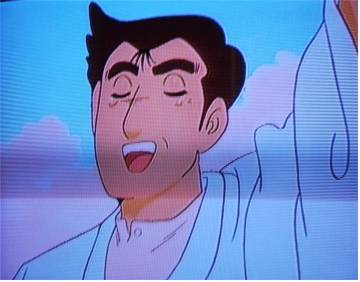|
Mikimoto Animation
|
Young Mikimoto joyful over first cultured pearl
The Kokichi Mikimoto animation at Pearl Island revealed his extremely keen sense of both observation and entrepreneurial genius.
As a youngster, for example, he noticed the high price people were paying for natural Ise Pearls from his area. Much more than was paid for his father's noodles, to be sure. He quickly assumed through simple logic that a greater abundance of oysters would mean more natural pearls, so he suspended tiles, stones and branches off of cables mounted between posts (like a clothesline) to allow more places for oysters to breed and attach themselves.

Because of the lucrative business Ise pearls brought, oysters were also harvested at dangerously high rates, which threatened them. In 1888, Mikimoto established the first pearl farm in the Shinmei Inlet in Shima.
Although the Mikimoto animation at Pearl Island is in Japanese, like all cartoons, they are easily understood for meaning.
When Kokichi Mikimoto was a boy, the British ship, "Silver," docked in the Port of Toba, his hometown. Local fishermen would row out to it and try to sell fish. Sometimes they were ignored by the British. But young innovative Kokichi wouldn't be over-looked. Much to the delight of the sailors, he entertained them by juggling wooden barrels with his feet while lying on his back in his little boat. This won him invitations on board the big ship.
The cartoon continues on through his life showing the trials of failed attempts at culturing pearls and concludes with the first beginnings of success...the day his wife Ume found the first cultured pearl.
So, thanks to Kokichi Mikimoto for his incredible ability to analyze and solve problems. Yes, others would have eventually solved this mystery, but the world should be grateful for this man.
After reading about the Mikimoto Animation at Pearl Island, return here to main Pearl Island page.






